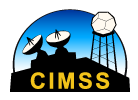On 03 July a multiple pyroCbs formed in Saskatchewan. The first formed at 20:45 UTC at 56.1 N 107.2 W, the second at 21:15 UTC at 56.6 N 107 W, and the third at 21:00 UTC at 57.3 N 108.3 W. GOES-15 detected the smoke plumes and pyroCb clouds, as well as the fire hot spot. Starting at 18:00 UTC on 03 July, the animation below shows visible (.63 μm) on the left and shortwave IR (3.9 μm) on the right (click image to play animation). In the shortwave IR images the red pixels indicate very hot IR brightness temperatures exhibited by the fire source region.
Furthermore, using GOES-15 10.7 μm IR channel the cloud-top IR brightness temperature could be found. The animation below, starting at 18:00 UTC on 03 July, shows the brightness temperatures of these pyroCbs. The first pyroCb reached -61.8ºC (yellow/orange color enhancement) around 21:35 UTC, the second pyroCb reached -52ºC (yellow color enhancement) around 21:35 UTC, and the third pyroCb reached -57.7ºC (yellow color enhancement) around 22:25 UTC.On 3 July at 20:48 UTC VIIRS shortwave IR image shows the widespread coverage of very large hot spots from the Canadian wildfires (indicated by red pixel color). Furthermore, the visible image shows the multiple smoke plumes produced from these wildfires and the smoke layer formed from the various wildfires in Alaska and Canada. The Saskatchewan pyroCbs can be seen on the right side of the image.

Suomi NPP VIIRS 3.74 µm shortwave IR, 0.7 µm Day Band, and 0.64 µm visible channel images (click to enlarge)
On 03 July OMPS Aerosol Index (AI) images were useful to see the transport of the smoke. From the AI image (below; courtesy of Colin Seftor), the max AI is 7.7 at 52.99 N 99.06 W at 19:06 UTC which is southeast of the fire. Furthermore, it can be seen that the smoke was being transported southwestward.
A local news station in Saskatoon, Saskatchewan captured this pyroCb. From the image below (courtesy of 650 CKOM) the pyroCb can be seen extending into the upper troposphere.
To further investigate the transport of smoke from this fire CALIPSO was used, this was very similar to the fire in Alberta. This LIDAR shows the height of the clouds from the wildfires. The first image below is the 532nm Total Attenuated Backscatter plot on 04 July from 19:46 UTC to 19:59 UTC. The smoke from these fires can be seen around 57 N indicated by a white/light grey color. Furthermore, since this LIDAR was used directly over the fire the particles that backscattered are in a formation of a smoke plume coming from the ground. Around 55 N the smoke particles begin around 2 km and increase linearly until reaching about 10 km. This proves that the LIDAR has indicated the source of the smoke and thus the source of one of the pyroCbs. The pyroCb is not indicated on this plot since it was taken at a later time in the day.In addition, the transport of smoke southeast is shown on the plot around 44 N.
The next image is the Depolarization image the smoke is indicated by a red/pink color. The third image is 1064 nm Total Attenuated Backscatter plot, the smoke on this plot is indicated by a light grey color. The fourth image is the Attenuated Ratio plot between 1064 nm and 532 nm. The smoke is indicated by the teal and purple pixels. The fifth image is the Vertical Feature Mask. This plot shows the different features that are in the atmosphere, the smoke is attributed as a cloud on this plot and is indicated by a light blue color. The last image shows the subtype of the aerosols that have been detected by the LIDAR. This shows that the aerosols that the LIDAR has detected are smoke (indicated by the black pixels) around 57 N and southeastward around 44 N. This LIDAR data helped to conclude the direction of the transport of the smoke from this fire.





























